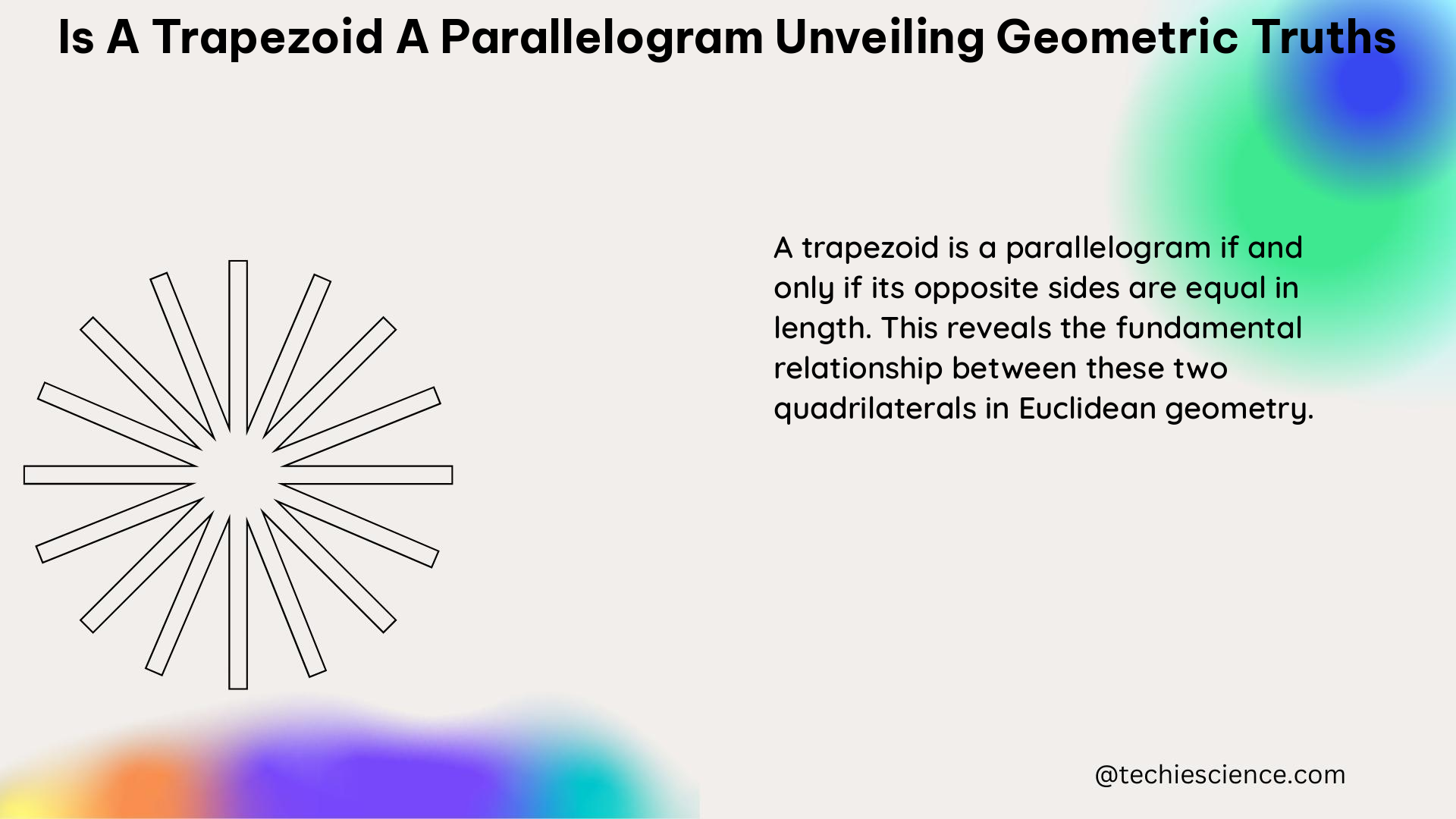A trapezoid is a quadrilateral with exactly one pair of parallel sides, while a parallelogram is a quadrilateral with two pairs of parallel sides. Understanding the properties and relationships between these two geometric shapes is crucial in unveiling the deeper truths of geometry.
Definitions and Properties
Trapezoid
A trapezoid is a quadrilateral with exactly one pair of parallel sides, known as the bases. The other two sides are called the legs of the trapezoid. The distance between the bases is called the height of the trapezoid.
There are several types of trapezoids:
1. Isosceles Trapezoid: A trapezoid where the non-parallel sides (legs) are congruent (have the same length).
2. Right Trapezoid: A trapezoid with one right angle (90-degree angle).
3. Scalene Trapezoid: A trapezoid where all four sides have different lengths.
Parallelogram
A parallelogram is a quadrilateral with two pairs of parallel sides. This means that both pairs of opposite sides are parallel to each other. The angles of a parallelogram are also equal in measure, and the diagonals of a parallelogram bisect each other.
There are several types of parallelograms:
1. Rectangle: A parallelogram with four right angles.
2. Rhombus: A parallelogram with all sides congruent.
3. Square: A parallelogram with four right angles and all sides congruent.
Relationship between Trapezoids and Parallelograms

Based on the definitions, we can conclude that a trapezoid is not a parallelogram, as it only has one pair of parallel sides. However, there are some special cases where a trapezoid can have additional properties that make it more similar to a parallelogram.
Isosceles Trapezoid
An isosceles trapezoid, where the non-parallel sides (legs) are congruent, has some properties that are similar to a parallelogram:
– The base angles of the trapezoid are congruent.
– The diagonals of the trapezoid are equal in length.
These properties make the isosceles trapezoid more similar to a rectangle, which is a type of parallelogram.
Right Trapezoid
A right trapezoid, which has one right angle, also has some properties that are similar to a parallelogram:
– The legs of the trapezoid are perpendicular to each other.
– The diagonals of the trapezoid are equal in length.
These properties make the right trapezoid more similar to a square, which is another type of parallelogram.
Quantifiable Data
Area Formulas
The area of a trapezoid is given by the formula:
Area = (base1 + base2) × height / 2
The area of a parallelogram is given by the formula:
Area = base × height
By comparing these formulas, we can see that the area of a trapezoid is always greater than or equal to the area of a parallelogram with the same base and height, as the trapezoid has an additional base that contributes to its area.
Perimeter Formulas
The perimeter of a trapezoid is given by the formula:
Perimeter = base1 + base2 + leg1 + leg2
The perimeter of a parallelogram is given by the formula:
Perimeter = 2(base + height)
These formulas show that the perimeter of a trapezoid and a parallelogram can be different, depending on the lengths of the sides.
Applications and DIY Projects
Trapezoids and parallelograms can be used in a variety of DIY projects and applications:
- Trapezoids:
- Creating pyramids or prisms
- Designing trapezoidal roofs or structures
-
Constructing trapezoidal shelves or storage units
-
Parallelograms:
- Constructing rectangular prisms or cubes
- Designing parallelogram-shaped furniture or decor
- Creating parallelogram-based patterns or designs
By understanding the properties and relationships between trapezoids and parallelograms, you can unlock a world of geometric possibilities in your DIY projects and problem-solving endeavors.
Conclusion
In summary, while a trapezoid is not a parallelogram, it has some special cases, such as the isosceles trapezoid and the right trapezoid, that make it more similar to a parallelogram. By understanding the definitions, properties, and quantifiable data associated with these shapes, you can deepen your understanding of geometry and apply this knowledge to a wide range of practical applications and DIY projects.
References:
– Area question involving trapezoid and parallelogram – Free Math Help
– Standards – Illustrative Mathematics | Kendall Hunt
– North Dakota Mathematics K-12 Standards
– GEORGIA’S K-12 MATHEMATICS STANDARDS 2021
– kindergarten math standards

The lambdageeks.com Core SME Team is a group of experienced subject matter experts from diverse scientific and technical fields including Physics, Chemistry, Technology,Electronics & Electrical Engineering, Automotive, Mechanical Engineering. Our team collaborates to create high-quality, well-researched articles on a wide range of science and technology topics for the lambdageeks.com website.
All Our Senior SME are having more than 7 Years of experience in the respective fields . They are either Working Industry Professionals or assocaited With different Universities. Refer Our Authors Page to get to know About our Core SMEs.